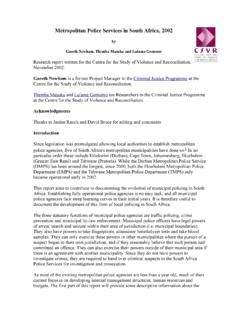Transcription of A 10-Year Perspective of the Merger of Louisville and ...
1 A 10-Year Perspective of the Merger of Louisville and Jefferson County, KY: Louisville Metro Vaults From 65th to 18th Largest City in the Nation Jeff Wachter September, 2013 1 Over the past 50 years, the idea of merging a city with its neighboring or surrounding county has been contemplated in many American cities, voted upon in a few, and enacted in even fewer. The most prominent American mergers have been Jacksonville, FL; Indianapolis, IN; Nashville, TN; and Lexington, KY. Other cities including Pittsburgh, PA and Memphis, TN have attempted mergers, but failed at various stages in the process. City/county consolidation has been a controversial topic, with advocates and opponents pointing to different metrics that support their expectations for the consequences of a Merger .
2 Louisville , KY, which merged with Jefferson County on January 1st, 2003, is the most recent example of a city/county consolidation executed by a major American city. This report examines how Louisville Metro has performed over the past decade since the Merger took effect by analyzing the city s economy, population, government spending and efficiency, and public opinion about the Merger . In the late 1990s, business and political leaders came together in an attempt to address some of the issues facing the Louisville region, including a long declining population and tax-base, escalating government spending, and multiple economic development organizations fighting to recruit the same businesses (often to the detriment of the greater Louisville region at-large).
3 These leaders determined that a Merger of the Louisville and Jefferson County governments was in the best interests of the region, despite the contentious nature of Merger debates. Proponents, after jumping through legal hoops in the state capital, managed to get a referendum scheduled for November 2000. A heated debate ensued, with opponents arguments that included fears of rising taxes, an unwieldy bureaucracy, and a loss of political strength for African-Americans. In the end, the proponents arguments that a Merger would increase government efficiency, help spur economic development, and create psychological benefits based on being a larger city (particularly when reminded that the merged Lexington-Fayette Urban County, KY, had surpassed Louisville in the 2000 census as the largest city in the state), persuaded voters to support merging the city and county by more than 24,000 votes, 54 percent in favor and 46 percent opposed.
4 In the decade since the Merger took effect, Louisville Metro has seen mixed results. The population has increased beyond the combined populations of the two former jurisdictions, though the bulk of the growth has occurred outside the old city limits. Employment is down slightly, though most of the jobs lost have been in manufacturing while the jobs that replaced them have been in professional and information sectors. The cost of government has not increased and fewer employees have been able to maintain services, and the bureaucracy is easier to navigate. And most importantly, a new sense of possibility has developed in the city, as residents and business leaders look toward a brighter future.
5 Background on Louisville and Jefferson County Prior to the Merger , Louisville , with 256,231 residents and located in the northern portion of Jefferson County, KY, was the 65th largest city in the United States. The city had been the largest in the state until the 2000 census, when a consolidated Lexington-Fayette Urban County surpassed it by more than 4,000 residents. Since the Merger , the city, now officially named Louisville -Jefferson County Metro Government ( Louisville Metro ), has regained the position as the largest city in Kentucky, the 18th largest city in the country, and the principal city of the 43rd largest metropolitan statistical area (MSA).1 The Louisville MSA encompasses 13 counties 1 National ranking uses the population of Jefferson County as the true population of Louisville Metro; Census Bureau; Census 2010; using American FactFinder; 2 in Kentucky and It is home to three Fortune 500 companies (Humana, Yum!)
6 Brands, and Kindred Healthcare) and the operations headquarters of UPS Airlines. Louisville s location along the Ohio River, on the Kentucky/Indiana border, in the center of the eastern portion of the United States, contributed heavily to its role as a major manufacturing base throughout much of the 20th century. It has been a classic case of a city that grew and peaked along with the nation s 20th century industrial power. Population growth was substantial in the 1930s through the 1950s, peaking in 1960 at 390, However, the city s population steadily declined from the 1960s to the 2000s, as residents moved to the suburbs or left the metro area entirely. The city s tax base shrunk as the population declined by more than a third over this period, challenging the city budgets to continue providing the services residents expected.
7 During this same time, a racial divide between Louisville and Jefferson County also grew more pronounced. By the 1960s, the white population began a steady decline. White flight peaked during the 1970s with more than 60,000 white residents moving out of Louisville . Over the same period, the total African-American population of the city remained relatively stable. These demographic changes resulted in a starkly different racial composition of the city, with the African-American population comprising 33 percent of Louisville by 2000, up from 18 percent in 1960,4 altering the socio-economic and political makeup of the city. Before the Merger , Jefferson County included 93 incorporated cities, including Louisville , each with its own local government, but within the jurisdiction of the county government.
8 After the Merger and additional consolidations, 83 cities remain within Louisville Metro, each relying on Louisville Metro for certain services previously provided by the county and voting in Louisville Metro elections for city council and mayor. Before the Merger , the county was run by an elected judge-executive and a three-member legislative body known as the Fiscal Court. Louisville was run by a mayor and a 12-member Board of Aldermen. Residents in Louisville voted and paid taxes in both Louisville and Jefferson County, and each provided different services to residents. The overlapping governmental jurisdictions, and the duplicative services that existed, proved to be a significant argument touted in favor of a Merger .
9 Joint Agencies Prior to the Merger Prior to the Merger , the city and county maintained multiple joint agencies. Most significant among them was the Jefferson County School District, which still runs the public school system for Louisville Metro. In 1975, the Jefferson County and Louisville school districts were merged by court order. The impetus for this decision was a lawsuit filed in 1971 regarding continued segregation in the schools. At that time the Louisville district s school population was heavily African-American, while the Jefferson County district s was primarily white. In order to address integration in the schools, a busing program was established. The introduction of busing in 1975 led to violent clashes and protests by whites, including a boycott by more than 50 percent of white students at the start of the 1975 school year and a walk-out of 38 percent of Ford Motor Company workers, temporarily closing the As a result of busing, white 2 Census Bureau; Census 2010; using American FactFinder; 3 Susan B.
10 Carter et al., eds., Historical Statistics of the United States: Earliest times to the Present, Millennial Edition (Cambridge, UK: Cambridge University Press, 2006). 4 Census Bureau; Decennial Census, 1950-2000; 5 Luther Adams, Way Up North in Louisville : African American Migration in the Urban South, 1930-1970 (Chapel Hill, NC: University of North Carolina Press, 2010), 193. 3 enrollment in the school district declined by more than 20 percent at the end of the 1970s. The county continued busing until 1992 and the court order was officially revoked in By the late 1990s, residents of the city and county had grown accustomed to the merged school district and the fact that it was already a single entity was likely a crucial element in the successful Merger vote in 2000.








